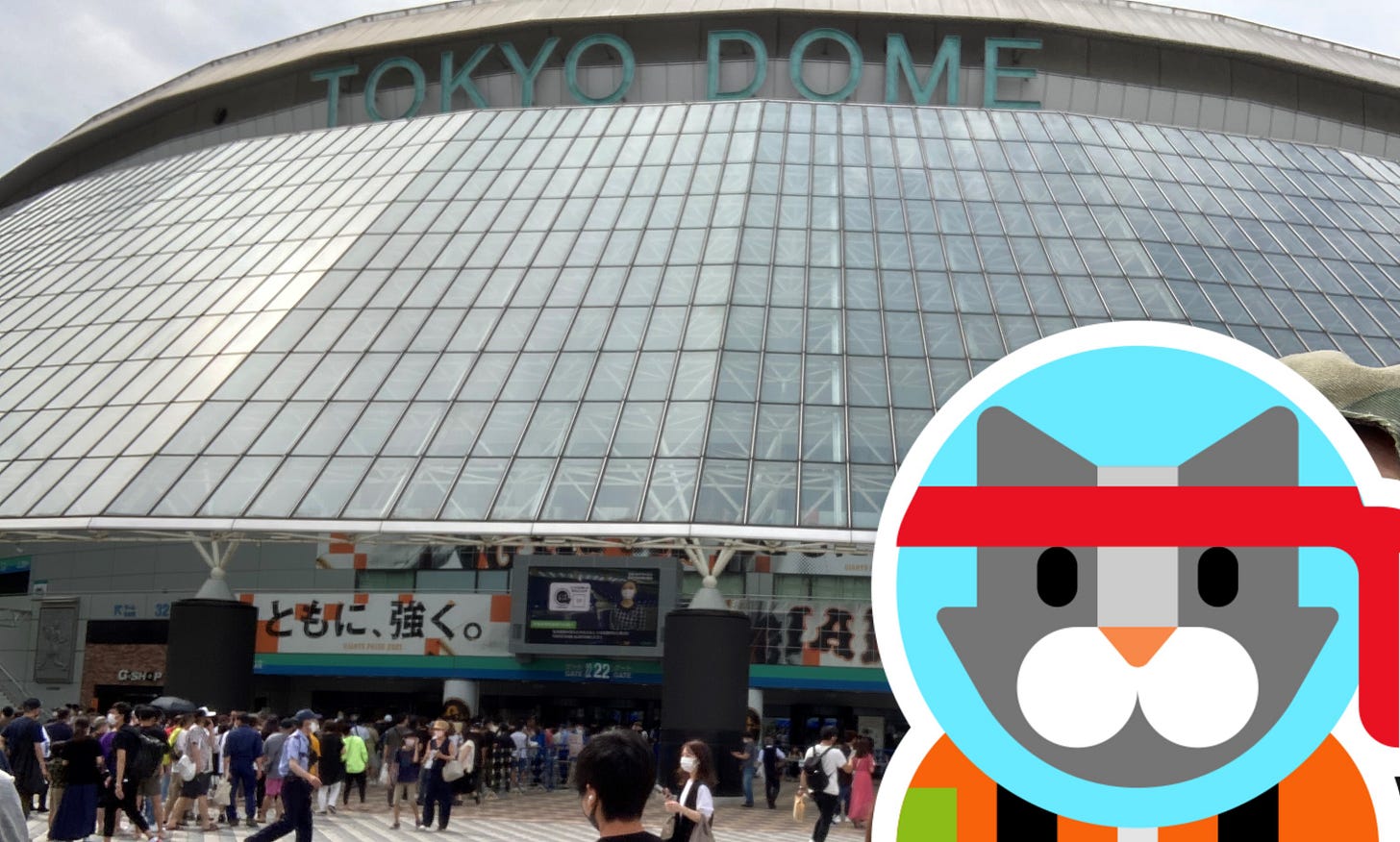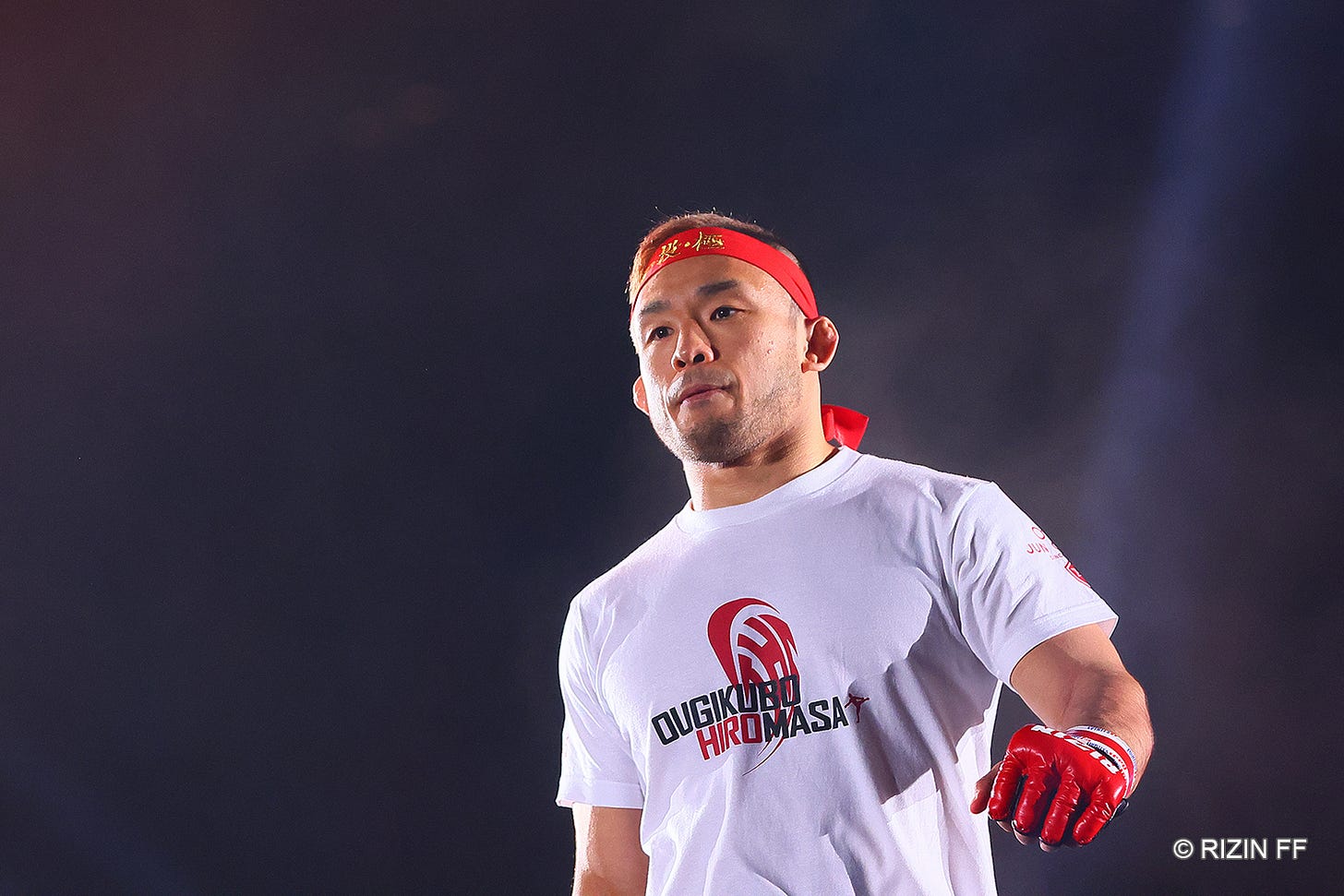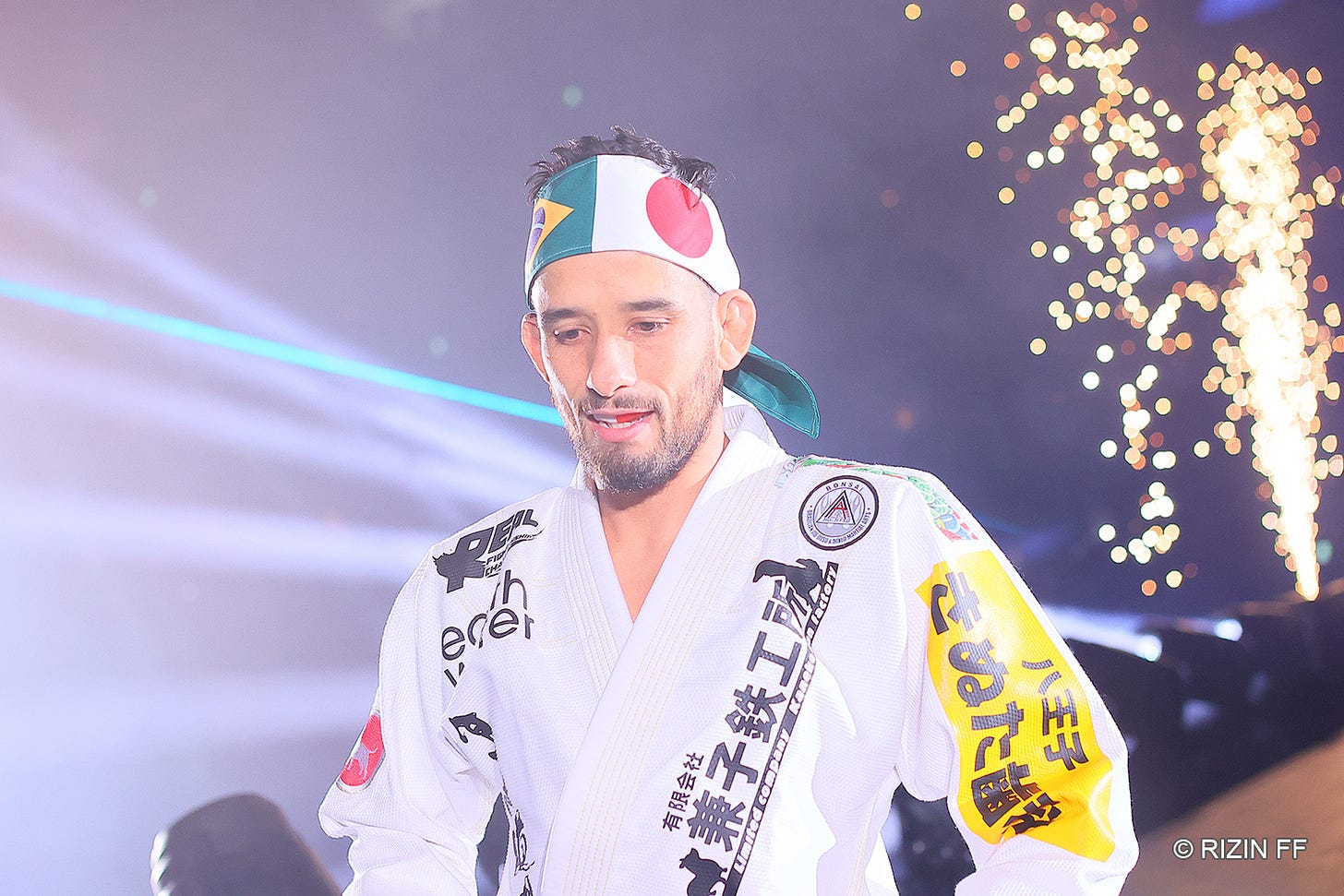As I walk towards the venue, any past reservations about COVID or otherwise sour feelings begin to fade, to be replaced by the nascent tingling of excitement. It’s an hour before the show and there’s already a good-sized crowd sitting outside in sunny Tokyo Dome Park – shops, restaurants, a Ferris wheel – and enjoying the afternoon. Who knows how many people are there for MMA, but the RIZIN merch tent seems to be doing a brisk business and there are lines waiting to enter the arena.
Inside is a similar scene with many people milling, sitting, watching, waiting for the excitement of Japanese MMA in Tokyo Dome for the first time in nigh two decades.
Tokyo Dome is home to the New York Yankees of Nihon Professional Baseball, the Yomiuri Giants, and the arena is set up for baseball. The outfield, upper deck, and mezzanine are empty and closed off for the event, with alternating infield lower deck seats available for spectators. The field is being used for seating as well for high-rollers, and probably not so high-rollers, just people not as cheap as me.
At 3:30PM, speakers kick in with sweet guitar rock and an introduction of the judges and functionaries and whatnot. Next up is something RIZIN generally does very well: a video introducing the evening’s fighters while giving them actual unique personalities and traits. This is in opposition to the cookie-cutter, anonymous, (very high-level) fight-technicians the UFC seems to churn out like tattooed widgets.
Then my favorite part of any RIZIN or PRIDE event: the walkouts at the beginning of the show as all the event’s fighters are introduced. Beloved RIZIN announcer, and former PRIDE announcer, Lenne Hardt breaks in with her trademark shriek, “We’re baaa-aaack!” The infectious RIZIN theme has me dancing in my seat and if I was home I’d be shuffling around the living room. My blood is pumping and good God, the banging concussion of fireworks in close proximity to my seat just scared the living shit out of me. And we’re off.
The first few fights are frankly not great, but several happenings illustrate something of the difference between MMA in Japan and the U.S.
Earlier in the day during UFC 263 (the previous night in the U.S.), an elite upper-tier show with two title fights, the fans booed seemingly constantly whenever the fighters were not just standing in front of each other winging punches - punching being only one aspect of mixed martial arts. While at RIZIN 28, during a fairly tentative heavyweight fight between Shoma Shibisai and Tsuyoshi Sudario, the crowd cheered the takedown and shrieked madly as the winner Shibisai maneuvered for a rear-naked choke. Without making any grand sweeping culture assumptions, there is certainly a different level of attention and awareness shown to the product. I chuckled during one particularly violent sequence when there was a clockwork of polite golf claps for a series of brutal knees to the head of a grounded fighter (this strike is illegal under U.S. MMA rules).
There was another peculiarly Japanese phenomenon of a fighter getting tossed out of the ring and injured in the fall. There are arguments on both sides for ring or cage that I will not make here, but for better or worse, that doesn’t happen in the UFC’s fully enclosed octagon. Another feature of JMMA we saw was several penalty cards being given to fighters, much like in a soccer/football game, which penalize the fighter for rules infractions and impact the fight’s scoring and their monetary winnings. This seems like a much better technique than the “soft” or “hard” verbal warnings from U.S. refs. There were also warnings for inaction, but those are more universal.
The feature showcase of RIZIN 28 and 29, the bantamweight grand prix tournament, started next as expected with veteran Yuki Motoya taking a win over Ryo Okada. This side of the bracket (as opposed to two weeks at RIZIN 29 in Osaka) is filled with the star power, but we’ll have to see how the fights all shake out. There’s a shift happening for the RIZIN bantamweights as the U.S.-based champ Kyoji Horiguchi seems disinterested with potential fights in RIZIN (he is not in the grand prix) and would rather fight the American champ in sometimes partner promotion Bellator. Below the champ are vets and younger fighters looking to push the vets out, and eventually the champ as well.
Veteran Hiromasa Ougikubo, who appeared on the UFC reality show The Ultimate Fighter, is in danger of being passed over by the young guns, but he grinds out a decision over Takeshi Kasugai and stays alive until the next round at least. In the next fight another fighter with UFC experience, Naoki Inoue, absolutely destroys the old guard in Shintaro Ishiwatari with a soccer kick to the face as the towel comes fluttering in from the corner. Top seed Kai Asakura violently takes care of his own business against Shooto Watanabe and my two picks for the final stay alive: I really want to see Asakura and Inoue go at it as the two representative young RIZIN bantamweights with real fighting skill and star potential (or in Kai’s case, somewhat realized stardom with his very popular YouTube account), with the winner getting Horiguchi.
The remainder of the first round will take place in two weeks; RIZIN has yet to announce the schedule after that, but presumably the final is slated for New Year’s Eve, the biggest night of the Japanese fighting calendar.
Só Danço Samba - Brazil Steals the Show
A Brazilian expat and an Azerbaijani military man face off for the inaugural RIZIN lightweight belt in the next fight as we make our way to the top of the card. Roberto Satoshi Souza walks out with Brazilian music playing and a Japanese flag draped around his shoulders. Souza has definitely embraced his adopted country and his patriotism is somewhat unique in a Japan that remains 99% homogenous and noticeably xenophobic in many ways.
There have been Japanese immigrants in Brazil since the 1900s, but since the 1980s the situation has reversed somewhat as Brazilian Japanese have come “home" and others have followed to work in automobile factories. Hamamatsu in Shizuoka prefecture is one such place that today has the largest concentration of Brazilians in Japan. Roberto Satoshi Souza and main event fighter Kleber Koike teach at Bonsai Jiu Jitsu in nearby Iwata and fight in RIZIN.
Souza comes into the fight as a major underdog to his more experienced opponent (with an equally interesting backstory) Tofiq Musayev, but wins in an amazing display of MMA jiu-jitsu that is breathtaking to watch. And he does it in a minute! In his past fights, he seemed to want to test his stand-up striking skills more, but here he knew to immediately go where his bread is buttered. The fact that he was able to do it so quickly and surely against a very tough opponent is a testament to his incredible skill.
Next up kickboxing superstar Tenshin Nasakawa gets his gimmick fight against three opponents (one after another, not all together, which would be superior as gimmicks go), because RIZIN can’t seem to come to an agreement with any legitimate potential opponents. I do dig his walk-out song though.
The “fight” turns out as dumb as I thought it would be. And worse yet, boring. In his post-fight speech, it seems that even Tenshin acknowledges this was a stupid idea, but he acquiesced for the sake of fighting in Tokyo Dome. He then announces New Year’s Eve will be his last fight with RIZIN and he will transition to boxing. If he’s interested in athletic excellence, at this point that’s really the only thing he can do.
The main event is a wild back and forth affair, but ends when Mikuru Asakura goes to sleep and wakes up talking about retirement. I’d tentatively picked Mikuru to win the fight, considering Koike’s seemingly suspect striking defense, but nothing was stopping the Brazilians tonight, who finished their fights in similar fashion. The several Brazilians in a section nearby mine go absolutely wild as the ref steps in to peel a limp Asakura off a wildly screaming Koike.
One has to wonder about Mikuru’s continued motivation to fight for a living as he successfully makes his way as a YouTube celebrity and beyond - I saw an ad with him selling watches as I walked through Shibuya just the other day. Mikuru may well be on his way out, but it seems certain Kai will continue at least.
As for the winners, in my RIZIN 27 “preview” I wrote a haiku celebrating the RIZIN Brazilians:
Small businessmen,
Homegrown Brasil gaijin stars
Souza and Koike
Now the two immigrant former factory workers and current instructors at Bonsai Jiu Jitsu are at the top of the RIZIN food chain, with Koike presumed to be next in line, and a favorite, for a title bout against current featherweight belt-holder Yutaka Saito. Their rise is an important story not only for MMA, but for a contemporary Japan that needs to come to grips with the realities of immigration in a rapidly shrinking country. If Japan is lucky, their story will be one of many.
Several times in the lead-up and during the day and evening of RIZIN 28 I was left wondering, why even bother doing this show at the Tokyo Dome? With the COVID-limited crowd it just didn’t make much sense to me. It can’t have been cheaper for RIZIN and they are much more familiar with the set-up and logistics of Saitama Super Arena. But as I was walking out of the venue into the June night, I realized that’s why RIZIN CEO Nobuyuki Sakakibara is considered an MMA visionary and I have a barely-there MMA Substack.
The symbol of returning to the big iconic venue was the message: We Are Back, from COVID, from the fall of PRIDE, from everything. It seems to be an appropriate message at this time (I retract that if RIZIN bankrupted themselves to make this happen). The event was effective and historic and felt right. It was different than a standard night in Saitama, along with being some pretty damn good fights. It may not have matched the grandeur, spectacle, and star power of the 2000 Pride Grand Prix or 2003 Final Conflict, but this is a different time with different resources, needs, and expectations. After a long journey to RIZIN 28 through the alien Bunkyo-ku wasteland, I discovered there is life on Mars after all.
All RIZIN 28 fights are now available to watch on RIZIN’s YouTube channel.
I’m not really sure what’s next for Fight Pizza, but you can subscribe to find out.










